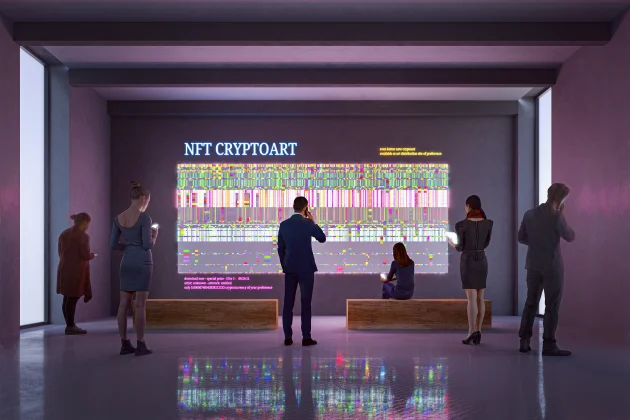NFT in art trade is here to stay

NFT has rapidly become an important part of art trading. NFTs are ‘non-fungible tokens’ with which digital art can be ‘tokenised’. This principle has been compared to buying an autographed print. The unique digital token proves ownership of the original work. The information cannot be duplicated, deleted or changed, and is encrypted and securely stored on Blockchain. This system has revolutionised the way information is safeguarded; crypto currencies such as Bitcoin are known users.
Beeple’s record sale
The digital proof of ownership can be bought and sold. NFT trade became an instant hit after the record sale in 2021 of digital work by the American artist Mike Winkelmann, better known as Beeple. Christie’s auctioned his ‘Everydays, the 5000 days’ for nearly 70 million dollar. It was the first fully digital artwork put up for auction at Christie’s, as explained at the time on Online Gallery.
The multi million dollar sale fuelled a hype. ‘Trade in NFT’s is still a modest part of worldwide art sales, but is greatly on the increase,’ concluded the Dutch financial newspaper FD this week, mentioning the following figures. ‘According to the annual report of the Art Basel fair the value of art sold through NFT platforms in 2021 is a hundred times higher compared to the previous year: 2,6 billion dollar. [..] In 2019 there were 1370 art byers active on these NFT-platforms and 865 sellers. Now there are 130.696 buyers and 84.182 sellers.’
New art buyers
FD newspaper has analysed the phenomenon and points at the important differences between traditional art trade and NFT trade. In general, ‘normal’ art work will stay for 25-30 years in the possession of the same owner, but on certain crypto platforms three quarters of art NFTs will be sold on within a month. At this moment it still is the new generation buying, and speculation certainly plays a role. NFT art trade attracts young, financially strong buyers who may be interested in future purchase of ‘tangible’ art, and in starting collections. This is a welcome addition to the target group, now that traditional art buyers are aging. Experts say the advantage of digital art for museums and collectors is that expensive -and inaccessible- storage space is not needed. However, museums are still reticent embracing the phenomenon, not least because of questions about how digital work needs to be insured, also how digital art must be conserved long term. This does not take away the fact NFT art trade is here to stay.


